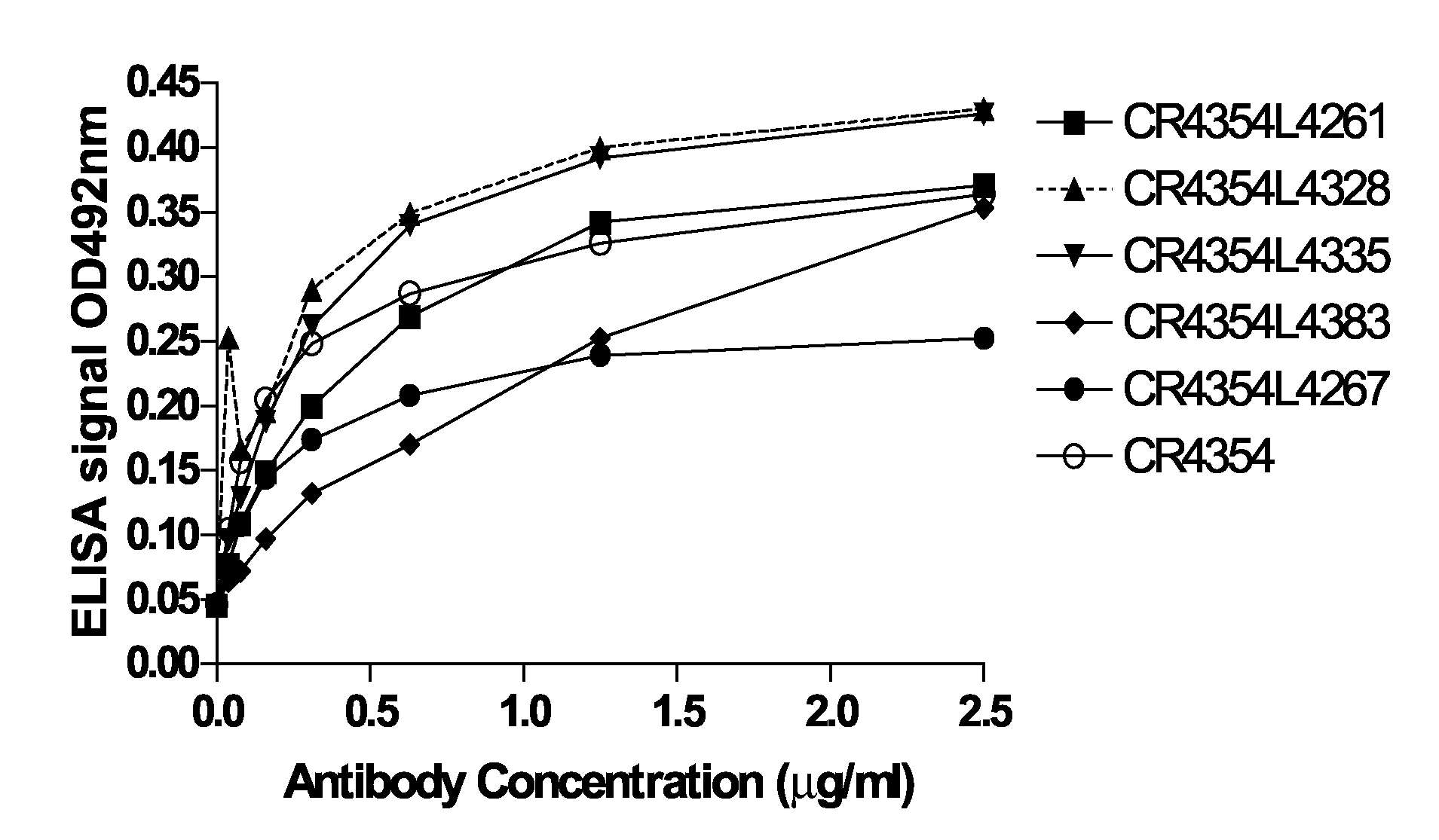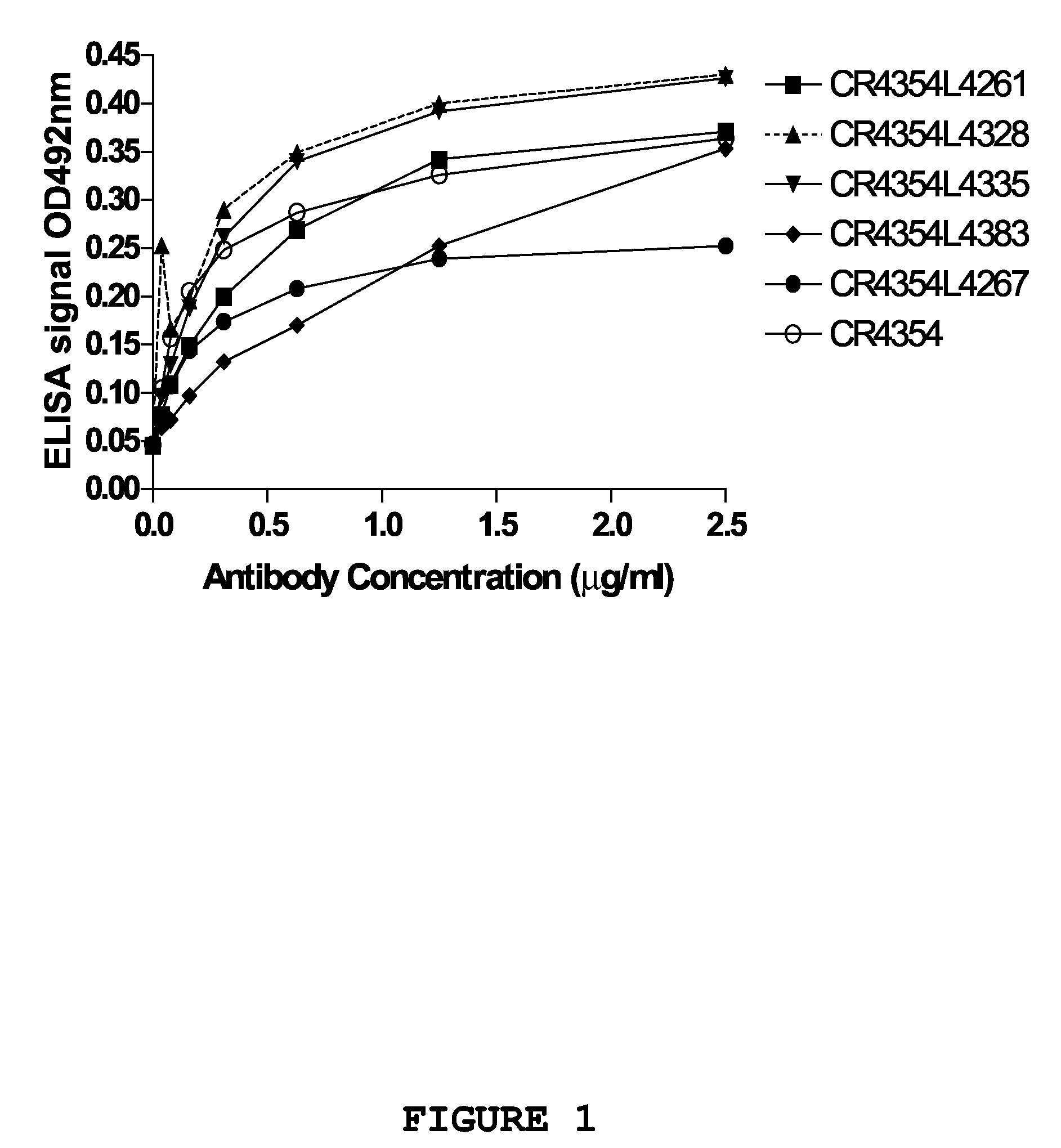Optimization of West Nile Virus Antibodies
a technology of antibody and west nile virus, applied in the field of binding molecules, can solve the problems of loss of original pairing, loss of variable region encoding sequence, and inability to recover the exact heavy chain variable region and light chain variable region pairs as present in the donor from a combinatorial library, so as to improve the functionality of interest and improve the effect of interes
- Summary
- Abstract
- Description
- Claims
- Application Information
AI Technical Summary
Benefits of technology
Problems solved by technology
Method used
Image
Examples
example 1
Construction of a ScFv Phage Display Library Using RNA Extracted from Peripheral Blood of WNV Convalescent Donors
[0029]From three convalescent WNV patients samples of blood were taken 1, 2 and 3 months after infection. Peripheral blood leukocytes were isolated by centrifugation and the blood serum was saved and frozen at −80° C. All donors at all time points had high titres of neutralising antibodies to WNV as determined using a virus neutralisation assay. Total RNA was prepared from the cells using organic phase separation and subsequent ethanol precipitation. The obtained RNA was dissolved in RNAse free water and the concentration was determined by OD260 nm measurement. Thereafter, the RNA was diluted to a concentration of 100 ng / μl. Next, 1 μg of RNA was converted into cDNA as follows: To 10 μl total RNA, 13 μl DEPC-treated ultrapure water and 1 μl random hexamers (500 ng / μl) were added and the obtained mixture was heated at 65° C. for 5 minutes and quickly cooled on wet-ice. The...
example 2
Selection of Phages Carrying Single Chain Fv Fragments Specifically Recognizing WNV Envelope (E) Protein
[0034]Antibody fragments were selected using antibody phage display libraries, general phage display technology and MAbstract® technology, essentially as described in U.S. Pat. No. 6,265,150 and in WO 98 / 15833 (both of which are incorporated by reference herein). The antibody phage immune library was prepared as described in Example 1. Furthermore, the methods and helper phages as described in WO 02 / 103012 (incorporated by reference herein) were used in the present invention. For identifying phage antibodies recognizing WNV E protein, phage selection experiments were performed using whole WNV (called strain USA99b or strain 385-99) inactivated by gamma irradiation (50 Gy for 1 hour), recombinantly expressed WNV E protein (strain 382-99), and / or WNV-like particles expressing WNV E protein (strain 382-99) on their surface.
[0035]The recombinantly expressed E protein was produced as f...
example 3
Validation of the WNV Specific Single-Chain Phage Antibodies
[0041]Selected single-chain phage antibodies that were obtained in the screens described above were validated in ELISA for specificity, i.e. binding to WNV E protein, whole inactivated WNV and WNV-like particles, all purified as described supra. Additionally, the single-chain phage antibodies were also tested for binding to 5% FBS. For this purpose, whole inactivated WNV, the WNV E protein, WNV-like particles or 5% FBS preparation was coated to Maxisorp™ ELISA plates. In addition whole inactivated rabies virus was coated onto the plates as a control. After coating, the plates were blocked in PBS containing 1% Protifar for 1 hour at room temperature. The selected single-chain phage antibodies were incubated for 15 minutes in an equal volume of PBS containing 1% Protifar to obtain blocked phage antibodies. The plates were emptied, and the blocked single-chain phage antibodies were added to the wells. Incubation was allowed to...
PUM
| Property | Measurement | Unit |
|---|---|---|
| Temperature | aaaaa | aaaaa |
| Fraction | aaaaa | aaaaa |
| Fraction | aaaaa | aaaaa |
Abstract
Description
Claims
Application Information
 Login to View More
Login to View More - R&D
- Intellectual Property
- Life Sciences
- Materials
- Tech Scout
- Unparalleled Data Quality
- Higher Quality Content
- 60% Fewer Hallucinations
Browse by: Latest US Patents, China's latest patents, Technical Efficacy Thesaurus, Application Domain, Technology Topic, Popular Technical Reports.
© 2025 PatSnap. All rights reserved.Legal|Privacy policy|Modern Slavery Act Transparency Statement|Sitemap|About US| Contact US: help@patsnap.com


